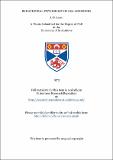Files in this item
Behavioural physiology of sea anemones
Item metadata
| dc.contributor.advisor | McFarlane, Ian | |
| dc.contributor.author | Lawn, Ian D. | |
| dc.coverage.spatial | 183 p. | en_US |
| dc.date.accessioned | 2018-06-25T14:10:07Z | |
| dc.date.available | 2018-06-25T14:10:07Z | |
| dc.date.issued | 1973 | |
| dc.identifier.uri | https://hdl.handle.net/10023/14548 | |
| dc.description.abstract | An investigation into the problems of control and coordination of activity in the sphincter muscle of Calliactis parasitica has revealed the presence of hitherto undiscovered inhibitory pathway located in the through-conduction nerve-net. The inhibitory system is responsible for delaying the onset of slow contractions in the sphincter for periods of up to 30 min or more, whereas fast contractions remain completely unaffected. It is suggested that the inhibitory effect may involve release of an inhibitory transmitter at the neuromuscular junction. From a study of spontaneous electrical activity in unstimulated preparations it has been shown that inhibitory responses may play an important role in the control and co-ordination of basic behavioural activity. These investigations underline the fact that the elementary nervous system possesses a functional complexity which belies its primitive structural organization. The nature of the mechanisms involved in the control and coordination of oral disc activity in Tealia feline has been investigated. It has been demonstrated that the ectodermal radial muscles of the oral disc show several different types of response. A slow conduction system, the ss1, has been shown to inhibit spontaneous activity and induce relaxation in the oral disc radials. It is suggested that these radials have a dual control system; excitatory from the nerve-net and inhibitory from the ss1. This work emphasizes the importance of the ss1 as a coordinating pathway in complex behavioural activities. Studies on sensory activity in the ss1 have revealed some interesting features of sensory physiology in sea anemones. Application of dissolved food substances to the column of Tealia feline elicits activity in the ss1. This chemosensory response shows a genuine adaptation that operates over a much extended time-scale compared with sensory responses of higher animals. The response may continue for periods in excess of 1 hr. Electrophysiological studies indicate that the chemoreceptors involved in this response are dispersed through-out the column ectoderm of Tealia, and are absent from the pedal disc and pharynx. Ultrastructural evidence is provided to suggest that these chemoreceptors are ciliated cells situated in the ectodermal epithelium of the column. These findings are discussed in relation to the pre-feeding response of Tealia and a model for oral disc expansion has been described. The significance of the new information derived from this study is discussed in relation to the evolution both of complex behaviour patterns, and of the mechanisms involved in control and coordination of activity in anemones. | en_US |
| dc.language.iso | en | en_US |
| dc.publisher | University of St Andrews | |
| dc.subject.lcc | QL377.C7L2 | en |
| dc.subject.lcsh | Sea anemones | en |
| dc.title | Behavioural physiology of sea anemones | en_US |
| dc.type | Thesis | en_US |
| dc.contributor.sponsor | Science Research Council (Great Britain) | en_US |
| dc.type.qualificationlevel | Doctoral | en_US |
| dc.type.qualificationname | PhD Doctor of Philosophy | en_US |
| dc.publisher.institution | The University of St Andrews | en_US |
This item appears in the following Collection(s)
Items in the St Andrews Research Repository are protected by copyright, with all rights reserved, unless otherwise indicated.

